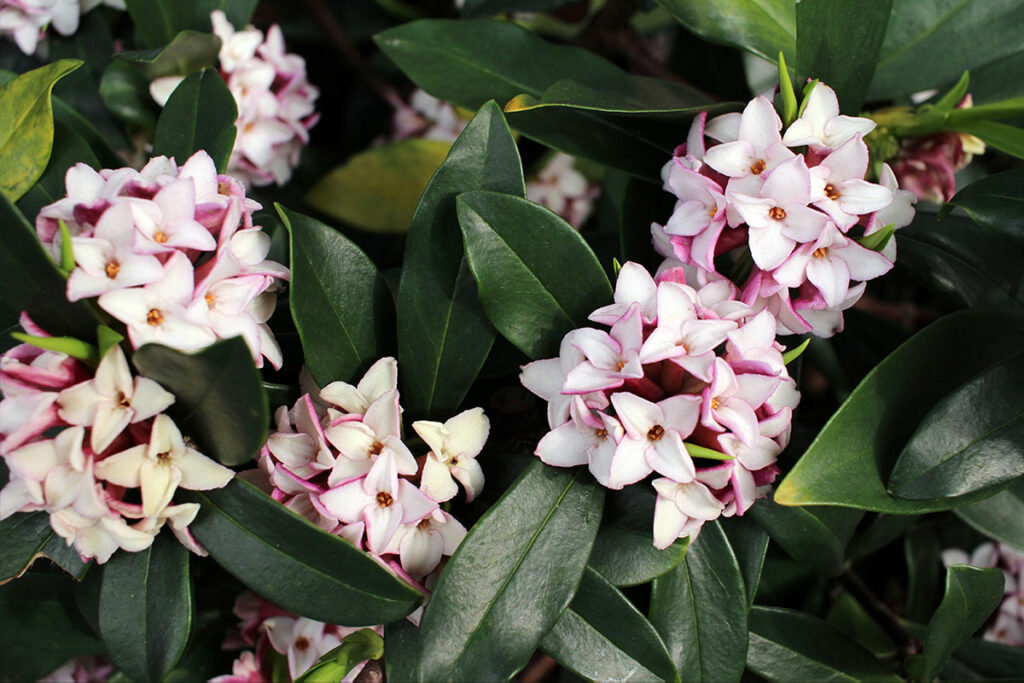
Winter Daphne (Daphne odora) is a beautiful, fragrant evergreen shrub that adds a pop of color and enticing aroma to your garden during the dull winter months.
In this article, we will guide you on how to plant and grow this elegant plant in your own garden sanctuary.
To successfully grow Winter Daphne, it’s essential to choose the right location and provide appropriate care. With the right conditions, this plant will thrive, showcasing its glossy green leaves and clusters of purple-pink flowers that will fill the air with a sweet scent.
Creating an enchanting garden retreat with Winter Daphne can be a rewarding experience. Follow along, and we’ll help you nurture a thriving, showstopping garden feature to enjoy on chilly winter days.
Ideal Climatic Conditions for Winter Daphne
Winter Daphne (Daphne odora) is a beautiful, fragrant shrub that blooms in late winter and early spring. To help it thrive in your garden, it’s crucial to provide the ideal climatic conditions for growth. Here’s a friendly guide on the factors to consider.
Temperature: Winter Daphne is cold-hardy and can survive in USDA Plant Hardiness Zones 7 through 9. This means the plant can tolerate winter temperatures as low as 10°F. However, it’s crucial to protect your Winter Daphne if temperatures drop below this range.
Sunlight: While Winter Daphne appreciates some sunlight, it’s essential to provide it with a location that receives partial shade, especially in the afternoon. Too much direct sunlight can scorch the leaves and cause the plant to struggle.

Wind: Winter Daphne can be sensitive to wind, so it’s best to position your plant in a sheltered spot where it can be protected from strong gusts. This will help prevent damage to the foliage and branches, allowing your shrub to grow strong and healthy.
Rainfall: Winter Daphne does well in areas with moderate rainfall. However, it’s crucial to ensure that your plant’s soil drains properly, as waterlogged soil can lead to root rot. Aim for soil that retains some moisture but does not remain soggy.
With these factors in mind, you’ll be able to provide the ideal climatic conditions for your Winter Daphne to flourish. Remember, looking after your plant’s needs will ensure a beautiful, fragrant addition to your garden year after year.
Choosing the Right Soil

For your Winter Daphne (Daphne odora) to thrive, it’s important to choose the right soil. Winter Daphne prefers well-draining soil that is rich in organic matter. This will help in providing essential nutrients and in regulating moisture levels for your plant.
Start by selecting a loamy or sandy loam soil, which has a good balance of sand, silt, and clay. This type of soil promotes proper aeration and drainage, crucial for the root system of your Winter Daphne. You can find this material at a local garden center or create your own mix by using equal parts garden soil, sand, and compost.
Amend the soil with additional organic matter, like aged compost or well-rotted manure. This will increase the nutritional content of the soil, promoting the healthy growth of your Winter Daphne. Aim for about 25% organic material blended into the existing soil. Additionally, it will help to maintain a slightly acidic pH range which Daphne odora prefers.
Another factor to consider is soil pH. Winter Daphne prefers a slightly acidic pH between 6.0 and 7.0. You can test the pH level of your soil using a home test kit or by sending a sample to a professional lab. If the pH is too high, you can gently lower it by incorporating elemental sulfur or aluminum sulfate. If it’s too low, add lime or wood ash to help raise the pH.
Lastly, ensure that the planting site for your Winter Daphne has good drainage. Poor-draining soils can lead to root rot, which is detrimental to the survival of your plant. To test if the soil drains well, dig a hole about a foot deep and fill it with water. If the water drains within an hour, the soil is well-draining. If not, consider planting your Winter Daphne in a raised bed or incorporate more sand into the soil to improve drainage.
Planting Winter Daphne
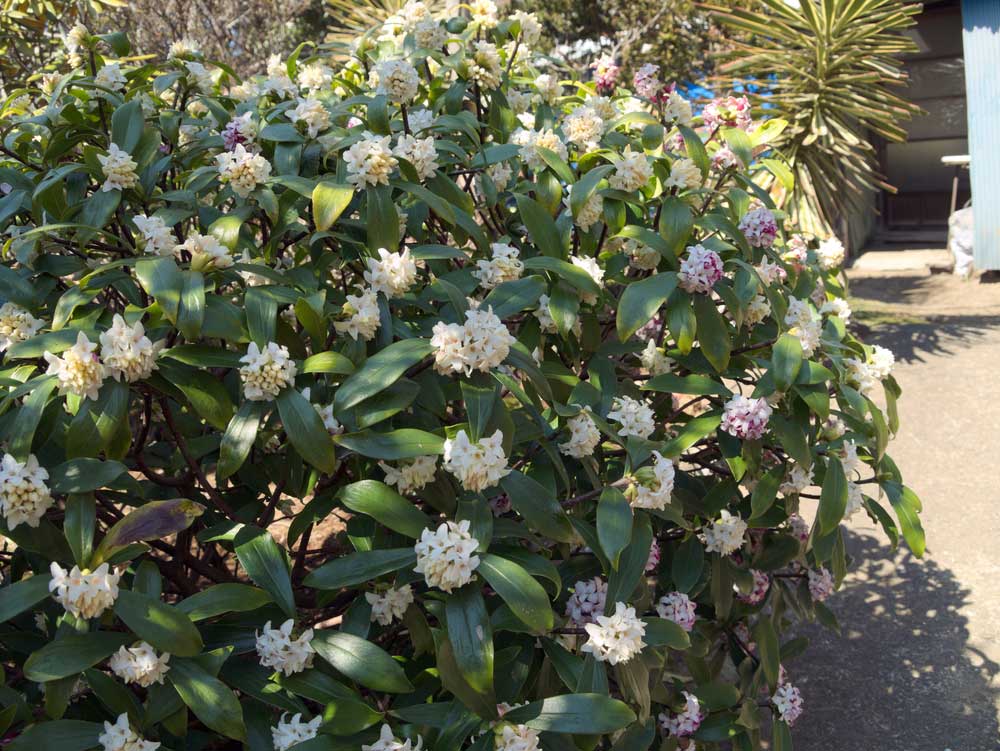
When to Plant
The best time to plant Winter Daphne is during the fall or early spring. This gives the roots enough time to establish themselves before the hot summer temperatures or harsh winter conditions. Remember that Winter Daphne thrives in USDA hardiness zones 7 to 9.
How to Plant
- Choose the right location: Winter Daphne prefers part-shade to full shade. Ensure the spot has well-draining soil and is protected from strong winds.
- Prepare the planting site: Loosen the soil in a planting area that is at least twice as wide as the root ball. If your soil is heavy clay, amend it with compost, peat moss, or coarse sand to improve drainage.
- Plant the Winter Daphne: Remove the plant from its container and gently loosen the roots. Dig a hole that is the same depth as the root ball and slightly wider. Place the plant in the hole, ensuring the top of the root ball is level with the soil surface.
- Backfill and water: Fill the hole with the soil you removed, gently firming it down as you go. Water the plant thoroughly to settle the soil around the root ball.
- Mulch and care: Apply a 2- to 3-inch layer of organic mulch (such as bark, compost, or leaf mold) around the plant to retain moisture and regulate soil temperature. Be sure to keep the mulch a few inches away from the base of the plant.
Now, your Winter Daphne should be well on its way to brightening your garden with its fragrant blooms and beautiful foliage. Enjoy the serene atmosphere it brings to your garden.
Watering Methods
When it comes to winter daphne, it’s crucial to learn the proper watering methods to ensure your plant thrives. Don’t worry, it’s quite simple, and with a friendly approach, we’ll guide you through the process.
To begin with, winter daphne prefers well-drained soil, which means you should avoid overwatering. Water your winter daphne once a week during its growing season. If your area experiences rainfall, adjust your watering schedule accordingly. Remember to always check the soil’s moisture level before you water; simply insert your finger about an inch deep into the soil. If it’s dry, it’s time to water your plant.
When watering, it’s best to use a slow, deep watering method. This promotes deep root growth, which ultimately strengthens your winter daphne. To do this, place a soaker hose or a drip irrigation system near the base of your plant and let it run for about 30 minutes. This method allows water to soak into the soil and reach the roots efficiently.
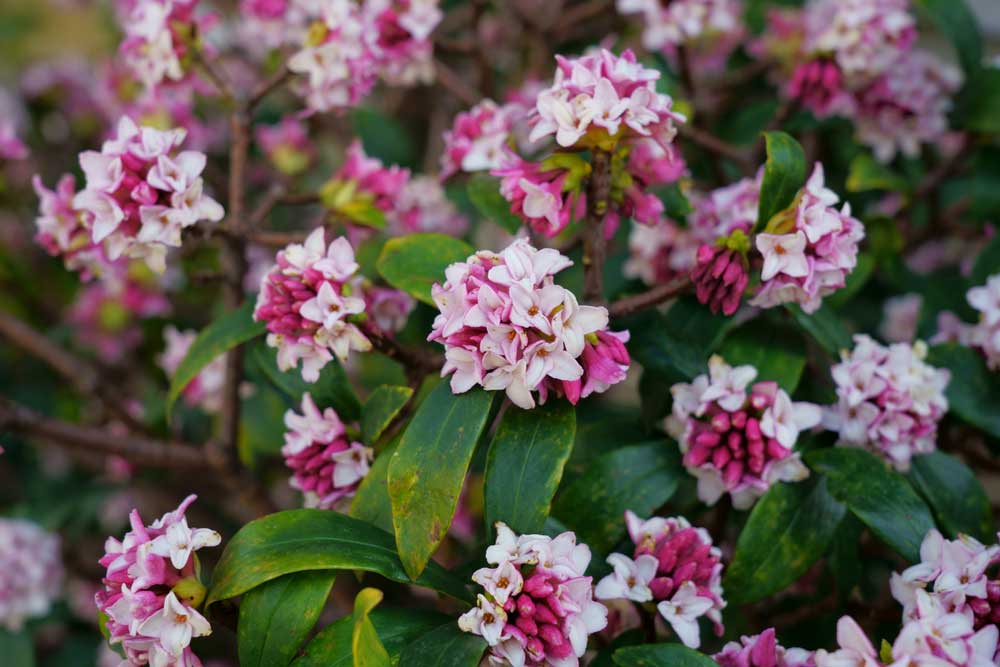
Here are some quick tips you should keep in mind to maintain your winter daphne’s health:
- Avoid letting the soil become too dry. Winter daphne is sensitive to drought, and it may cause its leaves to droop and fall off.
- Be mindful of excessive moisture, as it may lead to root rot and fungal diseases. Proper drainage is crucial for preventing these issues.
- Use mulch to help maintain soil moisture and regulate its temperature. A 2-3 inch layer of organic mulch should suffice.
With these simple, friendly tips, you’re now prepared to expertly water your winter daphne. Enjoy watching your plant flourish and grow throughout the season!
Fertilizing the Plant
To keep your Winter Daphne thriving, it’s important to provide it with the right nutrients. Start by choosing a slow-release fertilizer that is formulated for acid-loving plants, like rhododendrons or azaleas.
When applying the fertilizer, follow manufacturer instructions regarding the quantity you should use. A general rule of thumb is to apply it once in spring when new growth is beginning and once again in the early summer, before the hottest months. Don’t worry about fertilizing in the fall or winter, as this could stimulate unwanted growth.
To apply the fertilizer, gently spread it around the root zone, avoiding contact with the stem of your Winter Daphne. Then, water the plant thoroughly to help the fertilizer move into the soil and reach the root system.
Here are some additional tips for fertilizing Winter Daphne:
- Use a balanced fertilizer (with similar N-P-K ratios) to support healthy growth and flowering.
- When purchasing a fertilizer, look for one that contains essential micronutrients like iron, manganese, and zinc to help your plant thrive.
- Monitor the plant’s growth and overall health after fertilizing. If it seems to be struggling, try adjusting the fertilizer amount or frequency.
Remember, too much fertilizer can be harmful to your Winter Daphne, so it’s important to strike the right balance. By following these guidelines and adjusting as needed, you’ll help your plant grow strong and produce beautiful blooms throughout the winter months.
Pruning Winter Daphne
Pruning your Winter Daphne is an essential step to ensure its overall health and appearance. The best time to prune is right after it finishes blooming, usually in late spring. This helps maintain your Winter Daphne’s shape and encourage new growth.
To start pruning, you’ll need a clean, sharp pair of pruning shears. Begin by removing any dead or damaged branches. This will help prevent the spread of disease and pests, which can weaken your shrub. Be sure to also remove any branches that are crossing or rubbing against each other.
Next, focus on shaping your Winter Daphne. The ideal shape is slightly wider at the base than the top, to allow sunlight to reach all parts of the plant. Remove any branches that deviate from this form. Additionally, prune away branches that grow inwards toward the center of the shrub, as this can lead to overcrowding and poor air circulation.
Keep in mind that Winter Daphne does not respond well to heavy pruning. It’s important to only remove up to one-third of the shrub’s total branches each year. If your shrub is overgrown, plan to spread out the pruning process over a few years. This will allow your Winter Daphne to recover and regenerate in a healthy manner.
Finally, don’t forget to dispose of the pruned branches properly. Composting is an excellent, eco-friendly option, but be sure to check local regulations before doing so!
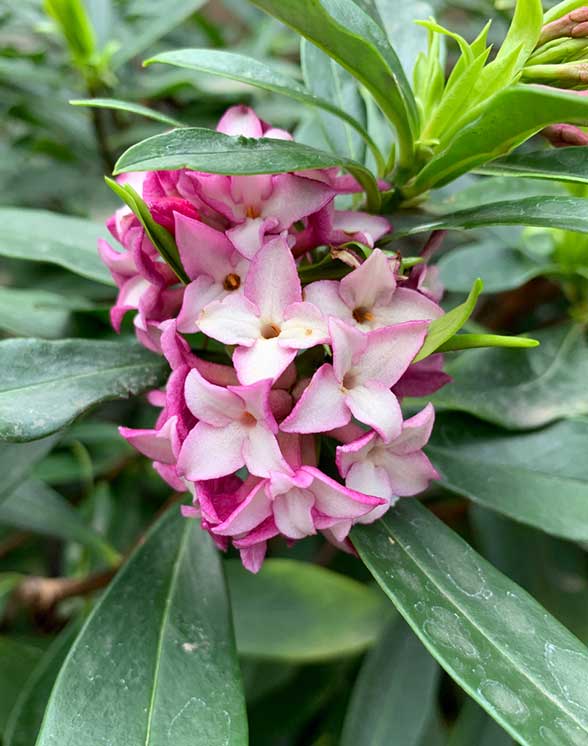
Potential Problems and Solutions
Common Pests
One issue you may encounter with Winter Daphne is common pests such as aphids, scale insects, and mealybugs. Here are some steps to tackle these pests:
- Monitor your plants regularly for visible signs of infestation.
- Use a strong blast of water to dislodge aphids from the plant.
- Introduce beneficial insects like ladybugs or lacewings to help control aphids.
- For scale insects and mealybugs, remove by hand or use a cotton swab dipped in rubbing alcohol.
- As a last resort, apply horticultural oil or insecticidal soap to treat the infestation.
Possible Diseases
Winter Daphne may also be affected by diseases like root rot and fungal leaf spots. To prevent and manage these diseases:
- Ensure proper drainage to avoid waterlogged soil, which can lead to root rot.
- Water at the base of the plant, and avoid splashing water on the leaves to prevent fungal infections.
- Prune away any affected leaves or branches and dispose of them properly.
- Apply a fungicide only if the problem becomes severe and other methods have not been successful.
Overcoming Weather Challenges
Weather challenges can impact the growth of your Winter Daphne. To help your plant thrive in various conditions, consider these tips:
- In areas with hot summers, provide afternoon shade or use a shade cloth to protect the plant from intense sun.
- For regions with cold winters, add a layer of mulch around the plant to insulate the roots.
- Ensure proper air circulation around your Daphne by giving it enough space and regularly pruning dense foliage.
- Be prepared to provide additional water during dry periods and consider a slow-release fertilizer if needed.
By addressing these potential problems, your Winter Daphne will grow beautifully and provide you with fragrant blooms.
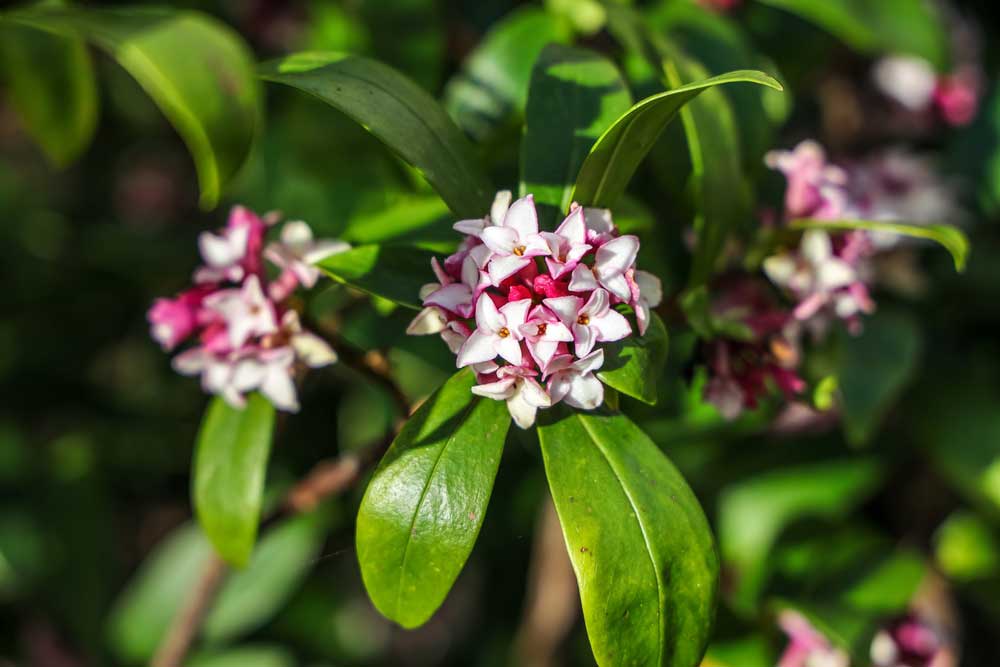
Frequently Asked Questions
What is the ideal soil type for growing Winter Daphne?
Winter Daphne thrives best in well-draining, fertile soil with a slightly acidic pH between 6.0 and 7.0. To provide the perfect growing environment for your Winter Daphne, you can amend the soil with organic matter such as compost or peat moss to improve its fertility and drainage.
How often should Winter Daphne be watered?
The key to healthy Winter Daphne growth is consistent watering. Water your plant thoroughly every few days, being careful not to over-water as this can lead to root rot. Keep the soil slightly moist, but not soggy. In drier periods or when temperatures rise, you might need to increase the frequency of watering to maintain soil moisture.
Which USDA zone is best for Winter Daphne?
Winter Daphne is best suited for USDA hardiness zones 7 through 9. It is less hardy in colder climates and may require extra protection during harsh winter months, such as applying a layer of mulch around the base of the plant or using a frost cloth. In warmer regions, pay particular attention to adequate watering to ensure optimal growth.
What type of sun exposure does Winter Daphne need?
Winter Daphne prefers partial shade or dappled sunlight. To provide the plant with the right light conditions, place it in a position where it receives shade from direct afternoon sun while benefiting from morning sunlight. Too much direct sunlight can scorch the leaves and impede blooming, while insufficient light can cause leggy growth and limit flowering.
Can Winter Daphne be grown from seeds?
Growing Winter Daphne from seeds is possible, but it can be quite challenging. It’s often more efficient to propagate Winter Daphne using semi-hardwood cuttings taken in late summer or early autumn. To grow from seeds, collect ripe seeds from the plant and sow them in a seed-raising mix, keeping them in a cool, shaded environment. Be patient, as germination can be slow and unpredictable. Once seedlings have reached a sufficient size, transplant them into individual pots and gradually expose them to more sunshine.




